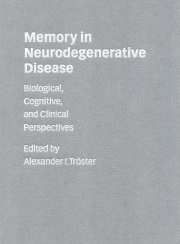Book contents
- Frontmatter
- Contents
- List of contributors
- Preface
- PART I Biological perspectives
- PART II Cognitive perspectives
- 8 The role of executive deficits in memory disorders in neurodegenerative disease
- 9 Prospective memory in aging and neurodegenerative disease
- 10 Remote memory in neurodegenerative disease
- 11 Semantic memory in neurodegenerative disease
- 12 Nondeclarative memory in neurodegenerative disease
- 13 Memory in neurodegenerative disease: what has been learned about the organization of memory?
- PART III Clinical perspectives
- Index
12 - Nondeclarative memory in neurodegenerative disease
from PART II - Cognitive perspectives
Published online by Cambridge University Press: 23 November 2009
- Frontmatter
- Contents
- List of contributors
- Preface
- PART I Biological perspectives
- PART II Cognitive perspectives
- 8 The role of executive deficits in memory disorders in neurodegenerative disease
- 9 Prospective memory in aging and neurodegenerative disease
- 10 Remote memory in neurodegenerative disease
- 11 Semantic memory in neurodegenerative disease
- 12 Nondeclarative memory in neurodegenerative disease
- 13 Memory in neurodegenerative disease: what has been learned about the organization of memory?
- PART III Clinical perspectives
- Index
Summary
INTRODUCTION
A number of recently conceived models of memory draw a distinction between relatively independent memory systems that differ from one another in the type of information stored and in the processes acting upon that information (Squire 1987; Tulving and Schacter 1990). One memory system dichotomy that has generated considerable theoretical and empirical interest is the distinction between declarative (or explicit) and nondeclarative (or implicit or procedural) forms of memory (Cohen and Squire 1980; Squire 1987). Declarative memory refers to knowledge of episodes and facts that can be consciously recalled and related (i.e. declared) by the rememberer. It has been characterized as ‘knowing that’ and includes such things as memory for the words on a recently presented list and knowledge that a cat is an animal. Nondeclarative memory, in contrast, is described as ‘knowing how’ and pertains to an unconscious form of remembering that is expressed only through the performance of the specific operations comprising a particular task. The use of nondeclarative memory is indicated by the performance of a newly acquired motor, perceptual or cognitive skill, for example, and by the unconscious facilitation in processing a stimulus that occurs following its previous presentation (i.e. priming).
The distinction that has been drawn between declarative and nondeclarative memory is based not only on conceptual grounds but also on the dissociation of these two forms of memory in patients with circumscribed amnesia arising from damage to medial temporal lobe or midline diencephalic brain structures.
- Type
- Chapter
- Information
- Memory in Neurodegenerative DiseaseBiological, Cognitive, and Clinical Perspectives, pp. 210 - 225Publisher: Cambridge University PressPrint publication year: 1998
- 4
- Cited by



